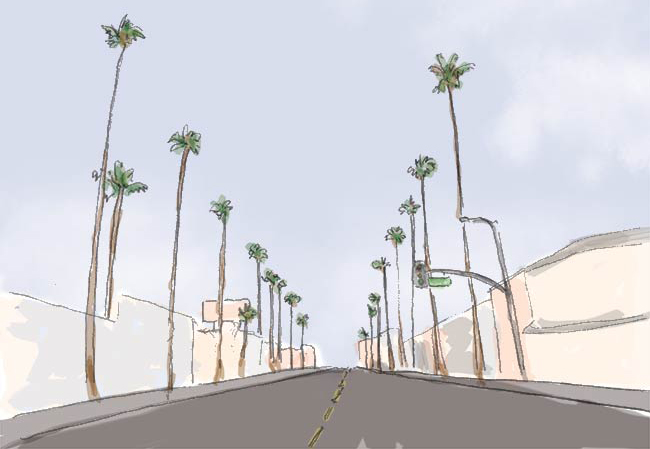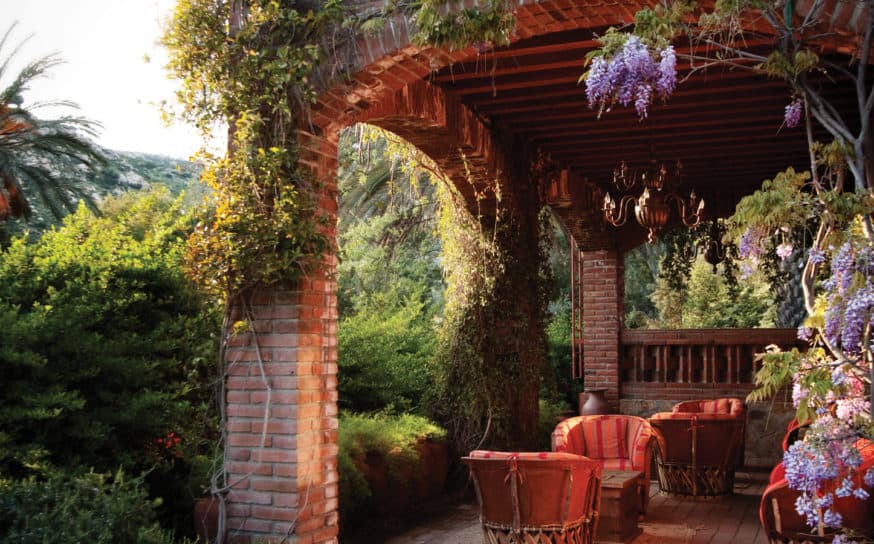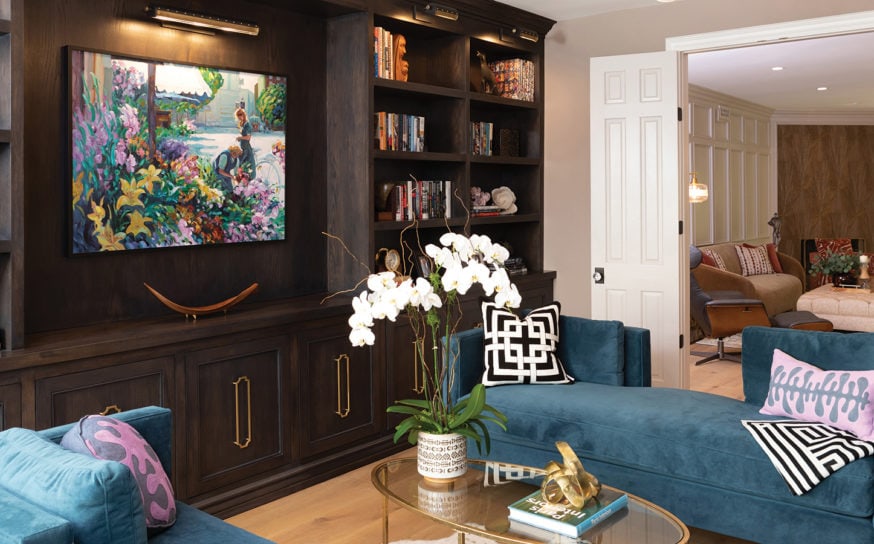
The State of Sherman Oaks
Six prominent locals, one table and no filter as they wrestle with what can be done to improve local traffic, how to boost retail along the Boulevard and why Sherman Oaks is fast becoming one of the best neighborhoods in LA.
-
CategoryUncategorized
Around the Table |
|
|---|---|
| Jonathan M. Brand | Chief of Land Use Planning Fourth District, city of LA |
| Bert Bogash | Treasurer, Sherman Oaks Chamber of Commerce |
| Leslie Danelian | Owner, Sweet Butter Kitchen |
| Matt Epstein | VP, Sherman Oaks Homeowners Association |
| Elke Heitmeyer | Board Member, Sherman Oaks Homeowners Association |
| Jeffrey Kalban | Founder and Vision Committee Chair, Sherman Oaks Neighborhood Council (*Jeffrey’s comments don’t necessarily represent the council’s views) |
| Moderator: Linda Grasso | Editor-in-Chief, Ventura Blvd magazine |
Let’s start with what everyone seems to be talking about these days: the restaurant boom along the Boulevard. Good thing? Too many?
Bert: Good restaurants bring more people into the area, and that is good for all the businesses on the Boulevard.
Leslie: I don’t think there are too many restaurants. As someone said, the millennials who grew up watching the Food Network are enamored with the culinary world and eating good food that is thoughtfully prepared.
I do think we are heavy on sports bars and in need of more contrasting dining establishments. There is a wine bar coming in where the old Brats Brothers was. I am looking forward to that! We need more restaurateurs to take chances on smaller-scale dining establishments as well.
Elke: I also hope the variety and independents will continue to be prevalent, so that we offer unique destinations and not just more chain locations.

What about five to 10 years down the road. Do you see the boom continuing?
Leslie: I think the restaurant boom will continue. Just look at all the new homes being built south of Ventura in Sherman Oaks! There will simply be more variety … hopefully like in New York or Paris.
Elke: If the economy continues to improve, I expect the restaurant trend to continue.
The other thing that seems to be on everyone’s mind these days: traffic. What can be done to improve traffic?
Matt: I’ve been in Sherman Oaks all my life, and traffic has gotten worse. The population has expanded. The good thing is that there has been a lot of investment in redevelopment. Mixed-use properties are great for the city, but it puts apartments and commercial together. Unfortunately the city has never had a long-term vision for planning.
There are easy solutions that the city won’t invest in. Ten years ago Antonio put a traffic regulator at major intersections like Coldwater and Beverly Glen. But instead of having one traffic officer there, writing tickets and actually make it pay for itself, they had two: one working and one sitting around wasting time. Basically no one would write tickets, and the program didn’t fund. So when the budget was cut, that got cut too.
The other thing that is stupid that the city is doing: They have some idiot looking at cameras and then using a computer trying to regulate signals. The person changes the lights so one car can make a left on a residential neighborhood, while the entire intersection is locked up—often for blocks. You take Hazeltine and Ventura Boulevard … what a joke!

Leslie: The top of Beverly Glen is bad too. Same thing happens.
How can we change that?
Matt: It is a rhetorical question. Council members are there for a certain length of time, and then they are out trying to figure out their next big thing. They pander to us for a while and then want to move on. They don’t care about the district. The issue of signal synchronization is not a priority. There is such a lack of planning on the part of the city. They built the subway for the two stops in NoHo. Where are the parking space structures for those? They don’t exist!
Jeff: Supposedly they are going to come. It is the commuter traffic that is the nightmare. Six hundred thousand cars pass through Sherman Oaks each day. That is round-trip: People going over the hill, through the canyons and coming back.
We need to find ways to stop some of that by creating more businesses and offices in Sherman Oaks. If we can get, say, 5% of cars off the road and get more people to stay in the Valley, it would ease up traffic in the canyons. We need to get better offices in the Valley—places with a certain vibe and design—where businesses want be. In my opinion, we have enough homes here. What we need is Class-A office space.
Elke: We should explore bringing back traffic programs, but instead of two traffic officers having one person at an intersection regulating traffic.
Matt: The enforcement of violations is lacking in the city. Look at Burbank. Burbank has strict restrictions on how many signs you can have for open houses: just four signs, and they have to be permitted by the city. On open house days they have someone who goes around and tickets. So what you have is an efficient system; you don’t have sign pollution. And the money goes back in the system. We have to think about how not to build more but to deal with what we have already more efficiently.
In terms of easing traffic along the Boulevard, what about a trolley like the ones they have in Laguna and in Ojai? I know that a trolley is part of the “Vision for Sherman Oaks” proposal the neighborhood council is currently working on, Jeffrey.
Jeff: It is an interesting idea. I was just up in Ojai, and they actually have two trolleys and they run every 10 minutes. In Sherman Oaks you could go from the Galleria to Fulton and back—and it could make stops at Kester, Woodman and Dixie Canyon. The trolley would be for residents.
Matt: How about a trolley that runs every half-hour along Valley Vista as well as the Boulevard? And maybe also Magnolia and Chandler—all the streets where you have a lot of residents who might walk a block or two to catch it.
Leslie: They should do it during holidays when you can’t find parking at the mall. Maybe offer it as a test and run it, say, every 10 minutes. Then once you get people starting to take it, you could run it every two minutes throughout the holidays.
Jon: That type of thing usually takes a partnership between local business, community, city and local governments to partnership.
Matt: Wouldn’t Westfield bend over backwards to put a “Westfield Sherman Oaks” trolley along the Boulevard? Or Ralphs or Trader Joe’s? They could put advertisements on it.

Jeff: The biggest issue would be: You would have to arrange places for the buses to stop.
Matt: I love the idea. The chamber would have to do it, and local businesses would have to back it.
I feel like we don’t have enough parking garages.
Bert: I don’t know where there is enough land to build structures. And I don’t know if SOHA would be against them. As a businessperson in Sherman Oaks , I can tell you parking is a major problem. There are places I don’t go, like west of Kester, because it is too hard to park on the street. It is all permitted parking.
Matt: Off-site parking fee. Easiest solution in the world. City collects hundreds of thousands of fees each year from communities like Sherman Oaks. That money does not go back to Sherman Oaks. It is bullshit. It goes into a general fund. You talk about building a parking structure? Easy: Manage the money that is being pulled out of Sherman Oaks. Let it create funds to create more parking. The change of use from retail to restaurant should happen, but if that restaurant doesn’t have parking, the city will not allow it to happen.
Look at what happened to Joan’s on Third. It took over a year for her to open in Studio City at the old post office location because she didn’t have the spaces.
Leslie: We could not expand because of that exact reason. We looked into it and hired a lawyer. It was just going to be too complicated because of parking, so we decided not to do it. And I’d like to open another restaurant. I have this amazing idea for a vegan place. But the idea of jumping through all these hoops and taking something that is not a restaurant and trying to turn it into one deters me.
Aside from easing up parking requirements, what else could we do to help businesses thrive along the Boulevard?
Leslie: It would be great if something could be done about deteriorating buildings.
Jon: A lot of them are buildings owned by trusts from multiple generations. They give them to a management company, and all they want is a check each month. Quite a bit of that. Nothing you can do about that.
Jeff: We just did a survey as part of the “Vision for Sherman Oaks” plan that the neighborhood council is currently working on. It was interesting to see where people shop and go to restaurants. It is usually in an area where they live and or work. There is big demand for better retail in Sherman Oaks. People want better men’s and women’s stores and bookstores.
How do we make that happen?
Jeff: The “Vision” is the first step. The City of LA has a general plan and specific plans but not a master plan in the traditional sense for the Valley or a community like Sherman Oaks, which would identify things like green spaces, opportunities for housing, retail, parking, etc. So we are trying to get groups like the chamber, the council and the homeowner’s association to unite, come up with a plan and get our city council member to support it. I can’t tell you how important it is for the “Vision” to get the right city council member for District Four elected in this upcoming election. Council support is essential.
The “Vision” is essentially a revitalization plan. It includes a concept for a plaza between Ventura Boulevard and Sherman Oaks Elementary, which would include lawns and provide an area for community events. It could be used for everything from celebrations to communal mourning. We’re also proposing landscaped medians. Pure visual appeal. Everyone loves a tree-lined street.
So making it more visually appealing will attract developers?
Jeff: Yes. Then you can talk to developers and tell them that we have a plan in place. They will look at Sherman Oaks and like what we are doing here and what they are seeing and want to be a part of it—whether they’re interested in building retail, mixed-use or office space.
Sherman Oaks has really improved from an aesthetic standpoint. It has become a much prettier neighborhood in the past 20 years.
Jon: One thing we did: We had medians that were dilapidated. We got a beautification team to do little complimentary things that the city doesn’t get to. Crews go out and dig out weeds in the medians and then replant.
Elke: Some businesses have lovely planters in front. It makes such a difference.
Matt: Those planters are against the city code.
Elke: So we have to change the city code, then. I kept talking to this liquor store on Kester and Ventura, and they finally repaved their parking lot—but they still have these planters with dried, dead plants.
If the community, SOHA and chamber could get together, we could do something like: “You water, and we plant.”
Jon: In the ‘90s there was tree-planting along the Boulevard. It paid off. Now we have full-grown trees.
Jeff: It was really hard to make that happen. We keep trying to locate areas for plantings. There are areas where you have traffic triangles like at Beverly Glen and Ventura. It is almost a no-brainer to plant there. You need council support.
Leslie: The more businesses that come here, the better it will look. When we opened Sweet Butter, Mark’s Garden then felt he had to make his business look better and renovated. It’s the trickle-down effect.
What about all the cracked sidewalks and dangers like sign poles that are hacked off and sticking straight up out of the cement? I can’t tell you how many times I’ve almost wiped out.
Matt: Just call 311 when you see something like that, and they will fix it.

Thoughts about all the pot shops that have popped up? Sherman Oaks doesn’t have as many as Studio City, but the number sure seems to be growing.
Leslie: There are too many of them, in my opinion.
Jon: They came in when there were a lot of vacancies. There is a certain amount grandfathered in, as long as they are at a distance from certain land uses (like schools). Others are not supposed to be there. The city attorney is going after them one by one.
Elke: I don’t see the problem. Stores are vacant. They are businesses that pay rent. There is no crime or humongous traffic resulting.
Bert: It goes back full-circle: How do we attract high-quality, upscale businesses to the Boulevard? Pot shops are proliferating? I’m not sure that is good for attracting upscale businesses.
What about all the homeless people in Sherman Oaks? It seems like there are more than ever—not just at the freeway exits and entrances but all up and down the Boulevard.
Bert: I’m hopeful and encouraged by what Tommy Newman (deputy, Fourth District, city of LA) is doing.
Jon: Tommy partnered with the business community and neighborhood groups to fund someone from LA Family Housing to work one day a week in Sherman Oaks. That person is talking to the people and trying to get a case started in an effort to get them off the streets.
Bert: Several community groups were able to come together to reach a common goal. The Sherman Oaks Chamber put $5,000 towards it; the council office put $2,500 to 3,000 in; and the homeowners association participated too.
Jon: Private citizens are donating too.
Elke: Tommy is thinking of putting out signs with a hashtag that essentially says: “If you really want to help the homeless, make a donation to LA Family Housing.”

I hear a lot of complaints from residents about overbuilding: Houses being built that they feel are too big for the lot.
Jon: The input I receive is that it comes down to the ones torn down. If they were in pretty bad shape and not being taken care of, locals don’t seem to mind. The issue is when a house is torn down and the rebuild is not, say, Cape Cod or ranch-style. It has things like large, Corinthian pillars and, say, a glass door with wrought-iron leaf designs—things you don’t typically see in those neighborhoods.
Elke: Styles should not matter. We can have a Corinthian next to a Cape Cod. Who cares? Size is the problem. Three-story homes on tiny lots. People don’t want a gigantic home towering above them next door.
Leslie: It is easy to see what is happening. People want value—the huge house with the big kitchen and center island. They know they can get their dream home in the Valley. People are moving here from the Westside. think it is fantastic—great for business.

Jon: In Sherman Oaks the homes torn down are the dumpiest ones on the block. New families are moving into the area, building beautiful homes, and people are happy about it. These are the people who are going to the cool, new restaurants—not my parents who have lived here for 40 years. They are going to the same places they’ve always gone to. New families coming here is a good thing.
At the risk of veering too far left: Why not build a stadium for an NFL team in the Valley?
Matt: We could call them the Sherman Oaks Gridlocks.
Jon: Did you know Jack Kent Cooke wanted to build his forum in Balboa Park? He got run out of town and built in Inglewood.
Matt: It’ll never happen. You don’t have the space.
Jeff: You could find the space. We are the fifth largest city in the country. We should certainly have a stadium as well as cult venues and museums.











